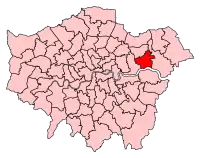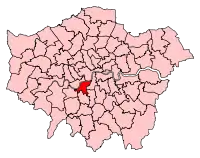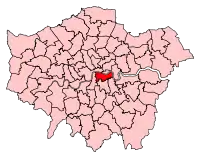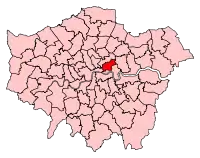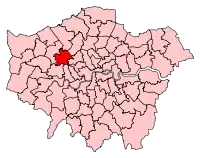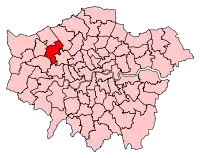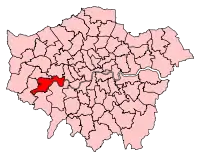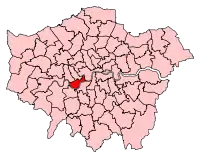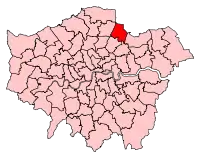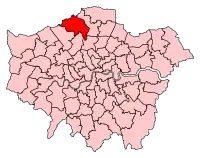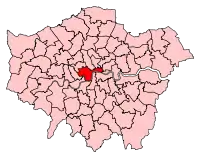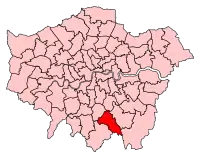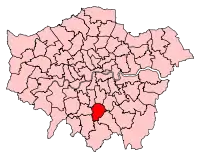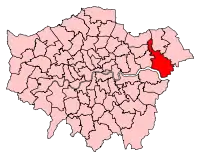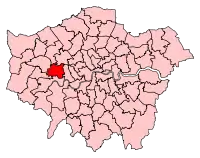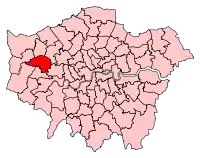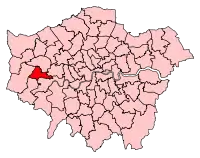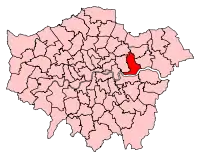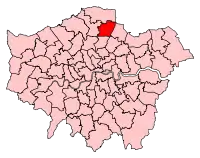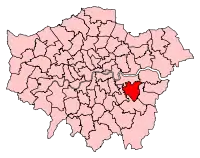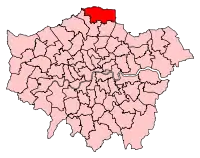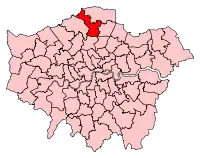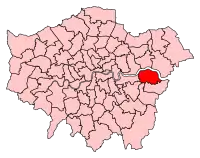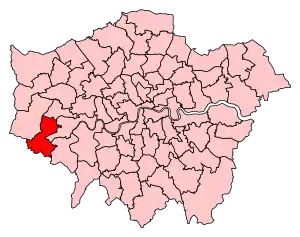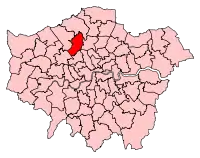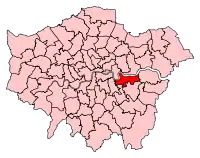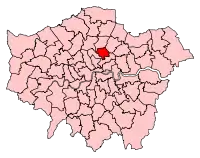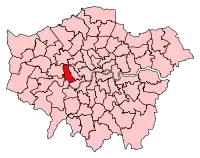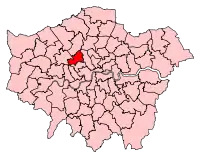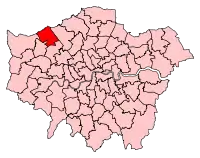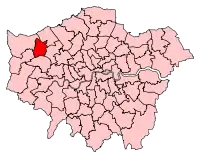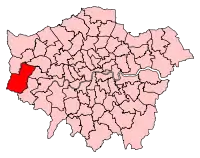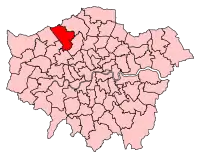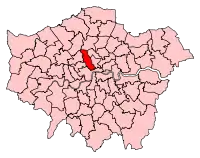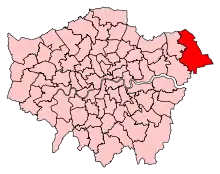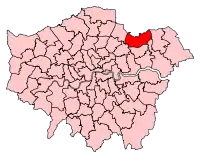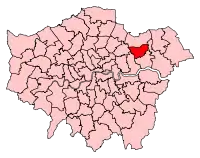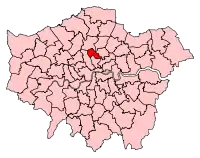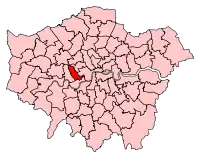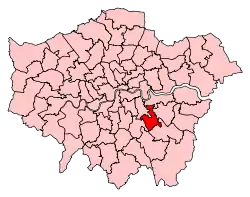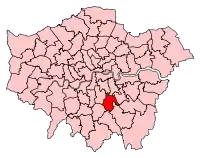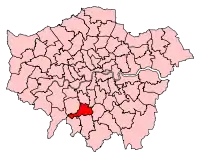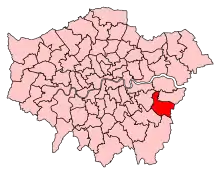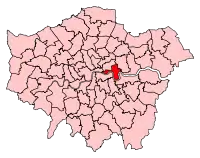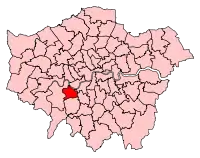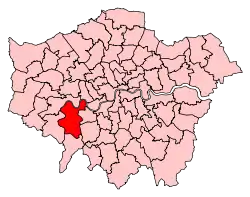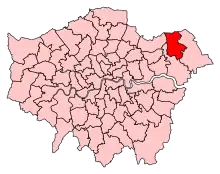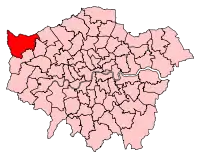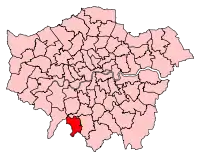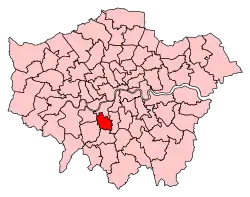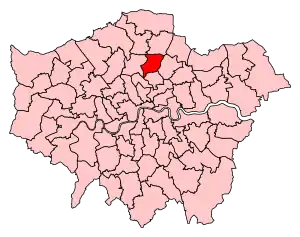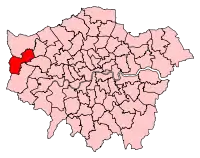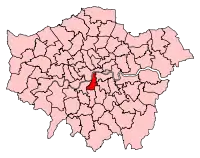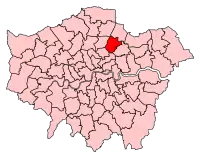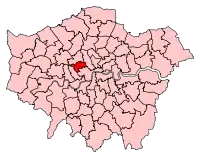List of Parliamentary constituencies in London
The region of Greater London, including the City of London, is divided into 73 parliamentary constituencies which are sub-classified as borough constituencies, affecting the type of electoral officer and level of expenses permitted.
.jpg.webp) |
|---|
| This article is part of a series on the politics and government of London |
|
|
Constituencies
† Conservative ‡ Labour ¤ Liberal Democrat ♣ Green Party
Results history
Primary data source: House of Commons research briefing - General election results from 1918 to 2019[3]
2019
The number of votes cast for each political party who fielded candidates in constituencies comprising the London region in the 2019 general election were as follows:
| Party | Votes | % | Change from 2017 | Seats | Change from 2017 |
|---|---|---|---|---|---|
| Labour | 1,812,810 | 48.1% | 49 | 0 | |
| Conservative | 1,205,129 | 32.0% | 21 | 0 | |
| Liberal Democrats | 562,564 | 14.9% | 3 | 0 | |
| Greens | 115,527 | 3.1% | 0 | 0 | |
| Brexit | 51,735 | 1.4% | new | 0 | 0 |
| Others | 18,355 | 0.5% | 0 | 0 | |
| Total | 3,766,120 | 100.0 | 73 |
Percentage votes
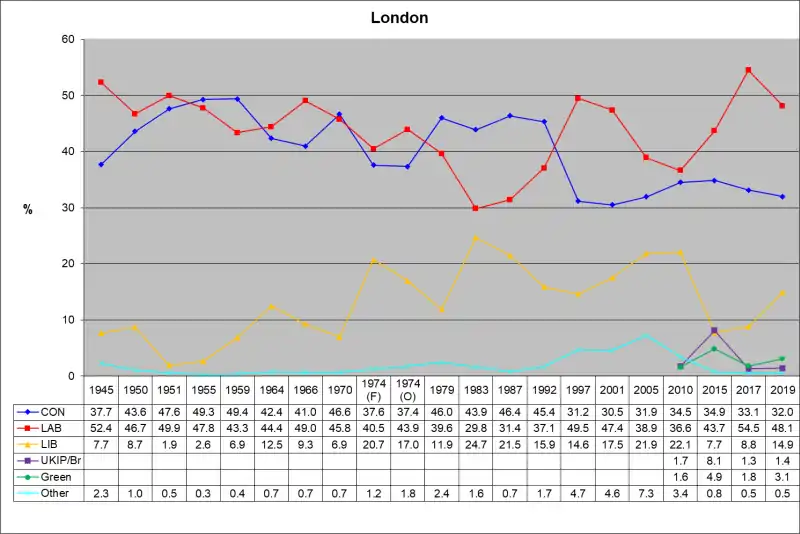
Key:
CON - Conservative Party, including National Liberal Party up to 1966
LAB - Labour Party
LIB - Liberal Party up to 1979; SDP-Liberal Alliance 1983 & 1987; Liberal Democrats from 1992
UKIP/Br - UK Independence Party 2010 to 2017 (included in Other up to 2005 and in 2019); Brexit Party in 2019
Green - Green Party of England and Wales (included in Other up to 2005)
Seats
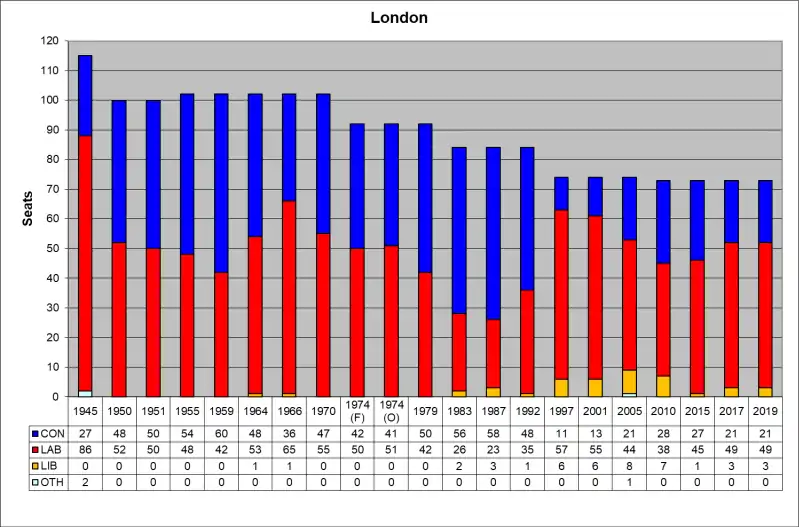
Key:
CON - Conservative Party, including National Liberal Party up to 1966
LAB - Labour Party
LIB - Liberal Party up to 1979; SDP-Liberal Alliance 1983 & 1987; Liberal Democrats from 1992
OTH - 1945 - (1) Communist Party; (2) Independent Labour (Denis Pritt); 2005 - Respect (George Galloway)
Maps
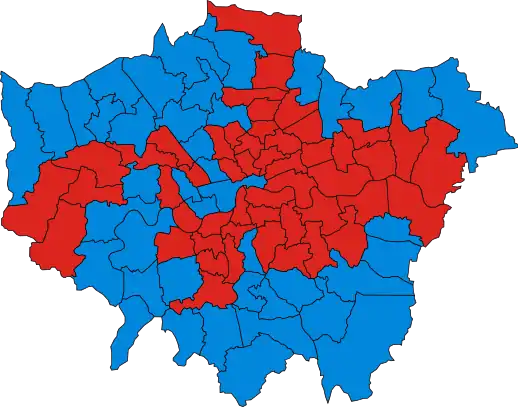 Feb 1974
Feb 1974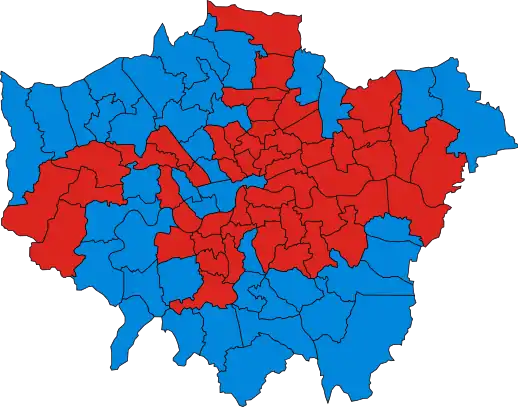 Oct 1974
Oct 1974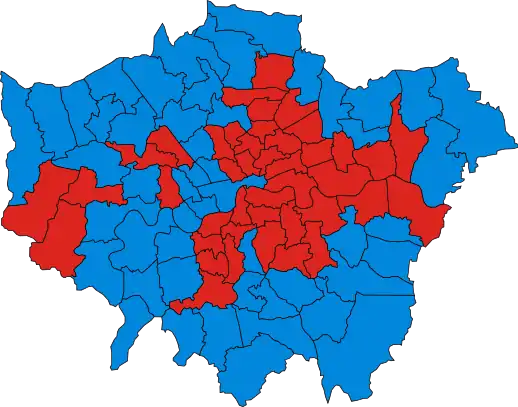 1979
1979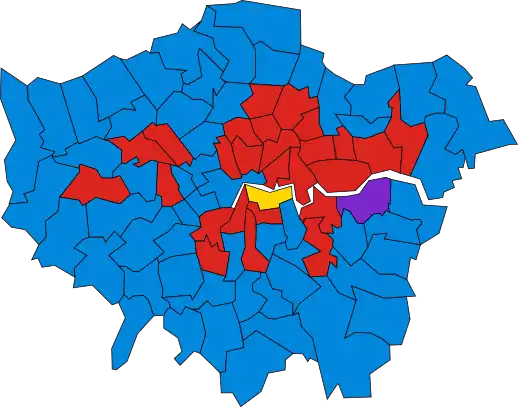 1983
1983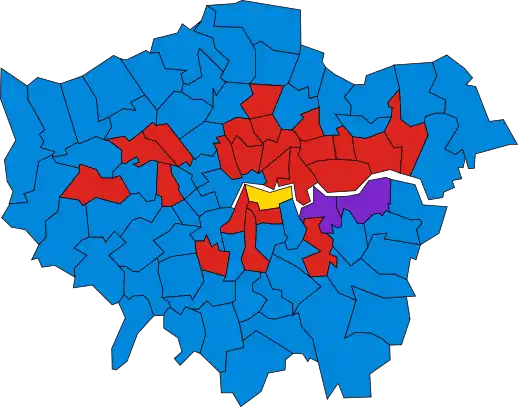 1987
1987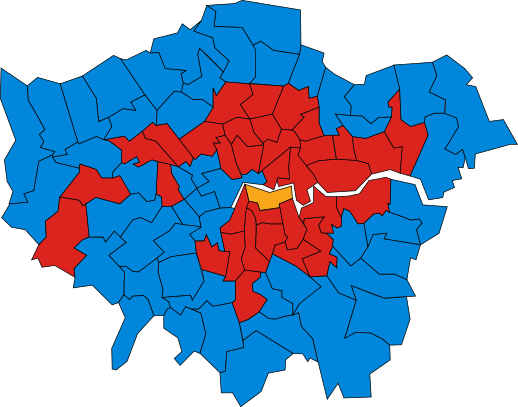 1992
1992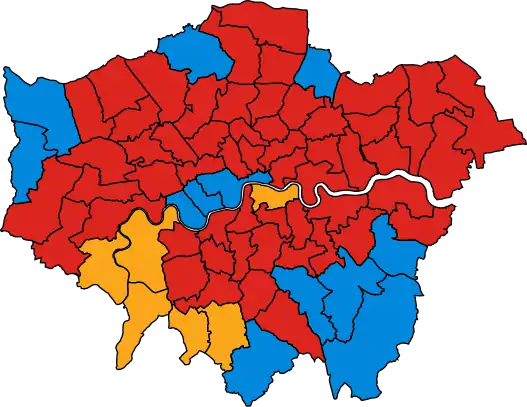 1997
1997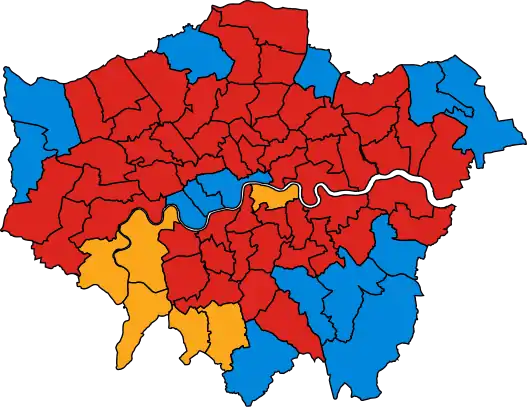 2001
2001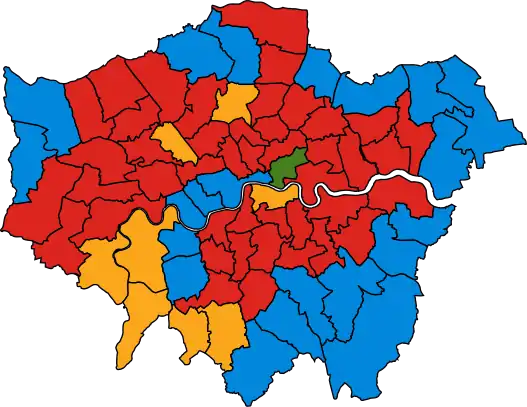 2005
2005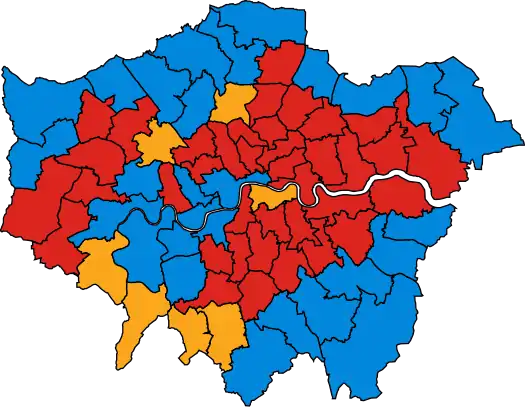 2010
2010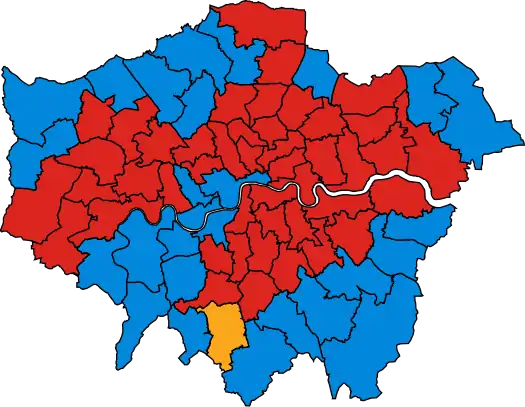 2015
2015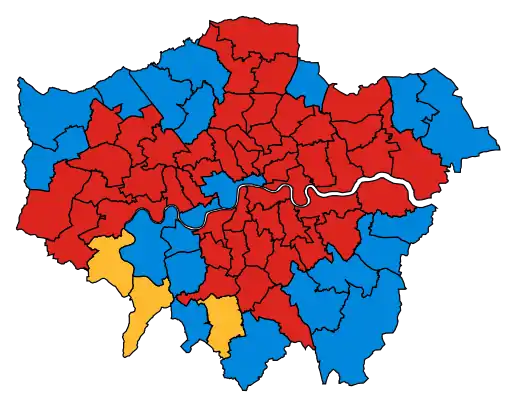 2017
2017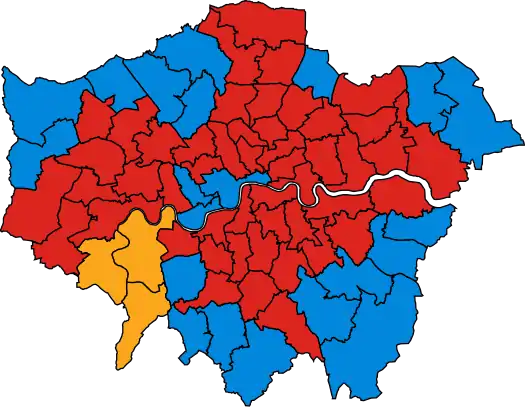 2019
2019
These are maps of the results of the last 13 general elections in London.
- Red represents seats won by MPs from the Labour Party.
- Blue represents seats won by MPs from the Conservative Party.
- Amber represents seats won MPs from the Liberal Democrats.
- Green (in 2005) represents the seat won by the sole MP from the Respect Party, George Galloway.
- Yellow (in 1983 and 1987) represents the seat won by the sole MP from the Liberal Party, Simon Hughes, who continued to be an MP of the Liberal Democrats.
- Purple represents the two seats won by MPs from the Social Democratic Party. They were John Cartwright (formerly Labour), and Rosie Barnes.
History
Metropolitan area and County of London (1832–1965)
The Reform Act 1832 gave representation to the London metropolitan area from eight parliamentary boroughs, known as the metropolitan boroughs.[4] This was expanded to ten boroughs in 1868. The Redistribution of Seats Act 1885 extended the area of parliamentary boroughs to the Metropolitan Board of Works area.
1832 to 1868
1868 to 1885
1885 to 1900
A cell marked → (with a different colour background to the preceding cell) indicates that the previous MP continued to sit under a new party name.
Conservative Liberal Liberal-Labour Liberal Unionist
1900 to 1918
Conservative Labour Liberal Liberal-Labour Liberal Unionist National Party
1918 to 1931
Coalition Liberal (1918–22) / National Liberal (1922–23) Communist Conservative Empire Free Trade Crusade Independent Independent Conservative Labour Liberal National Labour
1931 to 1950
Communist Conservative Independent Labour Independent Liberal Labour Labour Independent Group Liberal National Government National Labour National Liberal (1931–68)
1950 to 1965
1965 to 1974
Despite Greater London being created in 1965 the old constituency boundaries remained in place until 1974.
- For representation by party see sections North West, North East, South West and South East.
1974 to 1983
When Greater London was created in 1965 the existing constituencies crossed county boundaries. The constituency review reported in 1969, and was implemented for the February 1974 election. All 92 constituencies were contained within Greater London and each were within a single London borough, with the exception of the City of London and Westminster South. They were all borough constituencies.[5] The constituencies were also used as electoral divisions for the Greater London Council from 1973 to 1986.
- For representation by party see sections North West, North East, South West and South East.
- Acton
- Barking
- Battersea North
- Battersea South
- Beckenham
- Bermondsey
- Bethnal Green and Bow
- Bexleyheath
- Brent East
- Brent North
- Brent South
- Brentford and Isleworth
- Carshalton
- Chelsea
- Chingford
- Chipping Barnet
- Chislehurst
- City of London and Westminster South
- Croydon Central
- Croydon North East
- Croydon North West
- Croydon South
- Dagenham
- Dulwich
- Ealing North
- Edmonton
- Enfield North
- Erith and Crayford
- Feltham and Heston
- Finchley
- Fulham
- Greenwich
- Hackney Central
- Hackney North and Stoke Newington
- Hackney South and Shoreditch
- Hammersmith North
- Hampstead
- Harrow Central
- Harrow East
- Harrow West
- Hayes and Harlington
- Hendon North
- Hendon South
- Holborn and St Pancras South
- Hornchurch
- Hornsey
- Ilford North
- Ilford South
- Islington Central
- Islington North
- Islington South and Finsbury
- Kensington
- Kingston upon Thames
- Lambeth Central
- Lewisham Deptford
- Lewisham East
- Lewisham West
- Leyton
- Mitcham and Morden
- Newham North East
- Newham North West
- Newham South
- Norwood
- Orpington
- Paddington
- Peckham
- Putney
- Ravensbourne
- Richmond upon Thames
- Romford
- Ruislip Northwood
- St Marylebone
- St Pancras North
- Sidcup
- Southall
- Southgate
- Stepney and Poplar
- Streatham
- Surbiton
- Sutton and Cheam
- Tooting
- Tottenham
- Twickenham
- Upminster
- Uxbridge
- Vauxhall
- Walthamstow
- Wanstead and Woodford
- Wimbledon
- Wood Green
- Woolwich East
- Woolwich West
1983 to 1997
The constituencies were redrawn for the 1983 election. All 84 constituencies were contained within Greater London and each were within a single London borough, with the exception of the City of London and Westminster South. They were all borough constituencies.[6]
- For representation by party see sections North West, North East, South West and South East.
- Barking
- Battersea
- Beckenham
- Bethnal Green and Stepney
- Bexleyheath
- Bow and Poplar
- Brent East
- Brent North
- Brent South
- Brentford and Isleworth
- Carshalton and Wallington
- Chelsea
- Chingford
- Chipping Barnet
- Chislehurst
- City of London and Westminster South
- Croydon Central
- Croydon North East
- Croydon North West
- Croydon South
- Dagenham
- Dulwich
- Ealing Acton
- Ealing North
- Ealing Southall
- Edmonton
- Eltham
- Enfield North
- Enfield Southgate
- Erith and Crayford
- Feltham and Heston
- Finchley
- Fulham
- Greenwich
- Hackney North and Stoke Newington
- Hackney South and Shoreditch
- Hammersmith
- Hampstead and Highgate
- Harrow East
- Harrow West
- Hayes and Harlington
- Hendon North
- Hendon South
- Holborn and St Pancras
- Hornchurch
- Hornsey and Wood Green
- Ilford North
- Ilford South
- Islington North
- Islington South and Finsbury
- Kensington
- Kingston upon Thames
- Lewisham Deptford
- Lewisham East
- Lewisham West
- Leyton
- Mitcham and Morden
- Newham North East
- Newham North West
- Newham South
- Norwood
- Old Bexley and Sidcup
- Orpington
- Peckham
- Putney
- Ravensbourne
- Richmond and Barnes
- Romford
- Ruislip Northwood
- Southwark and Bermondsey
- Streatham
- Surbiton
- Sutton and Cheam
- Tooting
- Tottenham
- Twickenham
- Upminster
- Uxbridge
- Vauxhall
- Walthamstow
- Wanstead and Woodford
- Westminster North
- Wimbledon
- Woolwich
1997 to 2010
The constituencies were redrawn for the 1997 election. All 74 constituencies were contained within Greater London. Constituencies crossed borough boundaries between Bexley and Greenwich; Ealing, and Hammersmith and Fulham; Kensington and Chelsea, Westminster and the City of London; Kingston upon Thames and Richmond upon Thames; Lambeth and Southwark; Newham and Tower Hamlets; and Redbridge and Waltham Forest. They were all borough constituencies. [7]
- For representation by party see sections North West, North East, South West and South East.
- Barking
- Battersea
- Beckenham
- Bethnal Green and Bow
- Bexleyheath and Crayford
- Brent East
- Brent North
- Brent South
- Brentford and Isleworth
- Bromley and Chislehurst
- Camberwell and Peckham
- Carshalton and Wallington
- Chingford and Woodford Green
- Chipping Barnet
- Cities of London and Westminster
- Croydon Central
- Croydon North
- Croydon South
- Dagenham
- Dulwich and West Norwood
- Ealing, Acton and Shepherd's Bush
- Ealing North
- Ealing, Southall
- East Ham
- Edmonton
- Eltham
- Enfield North
- Enfield, Southgate
- Erith and Thamesmead
- Feltham and Heston
- Finchley and Golders Green
- Greenwich and Woolwich
- Hackney North and Stoke Newington
- Hackney South and Shoreditch
- Hammersmith and Fulham
- Hampstead and Highgate
- Harrow East
- Harrow West
- Hayes and Harlington
- Hendon
- Holborn and St Pancras
- Hornchurch
- Hornsey and Wood Green
- Ilford North
- Ilford South
- Islington North
- Islington South and Finsbury
- Kensington and Chelsea
- Kingston and Surbiton
- Lewisham, Deptford
- Lewisham East
- Lewisham West
- Leyton and Wanstead
- Mitcham and Morden
- North Southwark and Bermondsey
- Old Bexley and Sidcup
- Orpington
- Poplar and Canning Town
- Putney
- Regent's Park and Kensington North
- Richmond Park
- Romford
- Ruislip-Northwood
- Streatham
- Sutton and Cheam
- Tooting
- Tottenham
- Twickenham
- Upminster
- Uxbridge
- Vauxhall
- Walthamstow
- West Ham
- Wimbledon
Since 2010
The constituencies were redrawn for the 2010 election. All 73 constituencies are contained within Greater London. Constituencies cross borough boundaries between Barking and Dagenham, and Havering; Brent and Camden; Harrow and Hillingdon; Kensington and Chelsea, and Hammersmith and Fulham; Redbridge and Waltham Forest; Bexley and Greenwich; Bromley and Lewisham; Kingston upon Thames and Richmond upon Thames; Lambeth and Southwark; and Westminster and the City of London. They are all borough constituencies.[8]
- For representation by party see sections North West, North East, South West and South East.
- Barking
- Battersea
- Beckenham
- Bermondsey and Old Southwark
- Bethnal Green and Bow
- Bexleyheath and Crayford
- Brent Central
- Brent North
- Brentford and Isleworth
- Bromley and Chislehurst
- Camberwell and Peckham
- Carshalton and Wallington
- Chelsea and Fulham
- Chingford and Woodford Green
- Chipping Barnet
- Cities of London and Westminster
- Croydon Central
- Croydon North
- Croydon South
- Dagenham and Rainham
- Dulwich and West Norwood
- Ealing Central and Acton
- Ealing North
- Ealing Southall
- East Ham
- Edmonton
- Eltham
- Enfield North
- Enfield Southgate
- Erith and Thamesmead
- Feltham and Heston
- Finchley and Golders Green
- Greenwich and Woolwich
- Hackney North and Stoke Newington
- Hackney South and Shoreditch
- Hammersmith
- Hampstead and Kilburn
- Harrow East
- Harrow West
- Hayes and Harlington
- Hendon
- Holborn and St Pancras
- Hornchurch and Upminster
- Hornsey and Wood Green
- Ilford North
- Ilford South
- Islington North
- Islington South and Finsbury
- Kensington
- Kingston and Surbiton
- Lewisham Deptford
- Lewisham East
- Lewisham West and Penge
- Leyton and Wanstead
- Mitcham and Morden
- Old Bexley and Sidcup
- Orpington
- Poplar and Limehouse
- Putney
- Richmond Park
- Romford
- Ruislip Northwood and Pinner
- Streatham
- Sutton and Cheam
- Tooting
- Tottenham
- Twickenham
- Uxbridge and South Ruislip
- Vauxhall
- Walthamstow
- West Ham
- Westminster North
- Wimbledon
Proposed boundary changes
The Boundary Commission for England submitted their final proposals in respect of the Sixth Periodic Review of Westminster Constituencies (the 2018 review) in September 2018. Although the proposals were immediately laid before Parliament they were not brought forward by the Government for approval. Accordingly, they did not come into effect for the 2019 election which took place on 12 December 2019, and which was contested using the constituency boundaries in place since 2010.
Under the terms of the Parliamentary Voting System and Constituencies Act 2011, the Sixth Review was based on reducing the total number of MPs from 650 to 600 and a strict electoral parity requirement that the electorate of all constituencies should be within a range of 5% either side of the electoral quota.
On 24 March 2020, the Minister of State for the Cabinet Office, Chloe Smith, issued a written statement to Parliament setting out the Government's thinking with regard to parliamentary boundaries.[9] Subsequently, the Parliamentary Constituencies Act 2020[10] was passed into law on 14 December 2020. This formally removed the duty to implement the 2018 review and set out the framework for future boundary reviews. The Act provided that the number of constituencies should remain at the current level of 650, rather than being reduced to 600, while retaining the requirement that the electorate should be no more than +/- 5% from the electoral quota.
The Act specified that the next review should be completed no later than 1 July 2023 and the Boundary Commission formally launched the 2023 Review on 5 January 2021.[11] The Commission have calculated that the number of seats to be allocated to the London region will increase by 2, from 73 to 75.[12]
See 2023 Periodic Review of Westminster constituencies for further details.
Historical representation by party
A cell marked → (with a different colour background to the preceding cell) indicates that the previous MP continued to sit under a new party name.
North West London
The boroughs of Hillingdon, Harrow, Brent, Ealing, Barnet, Camden, Hammersmith & Fulham, Kensington & Chelsea and Westminster, and the City of London.
1965 to 1983
Conservative Labour Social Democratic Speaker
1983 to present
Conservative Independent Labour Liberal Democrats
North East London
The boroughs of Barking & Dagenham, Enfield, Hackney, Haringey, Havering, Islington, Newham, Redbridge, Tower Hamlets and Waltham Forest.
1965 to 1983
Conservative Independent Labour Labour Social Democratic
1983 to present
Change UK Conservative Labour Liberal Democrats Respect
South West London
The boroughs of Croydon, Hounslow, Kingston, Merton, Richmond, Sutton and Wandsworth.
Conservative Independent Labour Liberal Liberal Democrats Social Democratic Speaker
South East London
The boroughs of Bexley, Bromley, Greenwich, Lambeth, Lewisham and Southwark.
1965 to 1983
Conservative Labour Liberal Social Democratic
| Constituency | 1965 | 1966 | 1970 | 71 | 72 | Feb 74 | 74 | Oct 74 | 75 | 78 | 1979 | 81 | 82 | 83 |
|---|---|---|---|---|---|---|---|---|---|---|---|---|---|---|
| Bromley / Ravensbourne (1974) | Hunt | |||||||||||||
| Beckenham | Goodhart | |||||||||||||
| Bexley / Sidcup (1974) | Heath | |||||||||||||
| Streatham | Sandys | Shelton | ||||||||||||
| Orpington | Lubbock | Stanbrook | ||||||||||||
| Chislehurst | H-Smith | Macdonald | Hornsby-Smith | Sims | ||||||||||
| Bexleyheath | Townsend | |||||||||||||
| Erith and Crayford | Wellbeloved | → | ||||||||||||
| Woolwich West | Hamling | Bottomley | ||||||||||||
| Lewisham West | McNair-Wilson | Dickens | Gummer | Price | ||||||||||
| Lewisham North / Lewisham East (1974) | Chataway | Moyle | ||||||||||||
| Norwood | Smyth | Fraser | ||||||||||||
| Dulwich | Silkin | |||||||||||||
| Deptford / Lewisham Deptford (1974) | Silkin | |||||||||||||
| Peckham | Corbet | Lamborn | Harman | |||||||||||
| Vauxhall | Strauss | Holland | ||||||||||||
| Bermondsey | Mellish | Hughes | ||||||||||||
| Greenwich | Marsh | Barnett | ||||||||||||
| Woolwich East | Mayhew | → | Cartwright | → | ||||||||||
| Brixton / Lambeth Central (1974) | Lipton | Tilley | ||||||||||||
| Clapham | McKay | Shelton | ||||||||||||
| Lewisham South | Johnson | |||||||||||||
| Southwark | Gunter | Lamborn | ||||||||||||
1983 to present
Change UK Conservative Independent Labour Liberal Liberal Democrats Social Democratic (1983–88) & Social Democratic Party (1988–90)
See also
Notes
- The majority is the number of votes the winning candidate receives more than their nearest rival.
References
- Baker, Carl; Uberoi, Elise; Cracknell, Richard (28 January 2020). "General Election 2019: full results and analysis". Cite journal requires
|journal=(help) - "Constituencies A-Z - Election 2019". BBC News. Retrieved 25 April 2020.
- Watson, Christopher; Uberoi, Elise; Loft, Philip (17 April 2020). "General election results from 1918 to 2019". Cite journal requires
|journal=(help) - British Library
- "The Parliamentary Constituencies (England) Order 1970" (PDF).
- "The Parliamentary Constituencies (England) Order 1983" (PDF).
- "The Parliamentary Constituencies (England) Order 1995".
- "The Parliamentary Constituencies (England) Order 2007" (PDF).
- "Update: Strengthening Democracy:Written statement - HCWS183". UK Parliament. Retrieved 20 April 2020.
- "Parliamentary Constituencies Act 2020".
- "2023 Review launched | Boundary Commission for England". Retrieved 8 January 2021.
- "2023 Review | Boundary Commission for England". Retrieved 8 January 2021.
External links
- "BBC VOTE2005". Results: London. Retrieved 28 August 2005.
